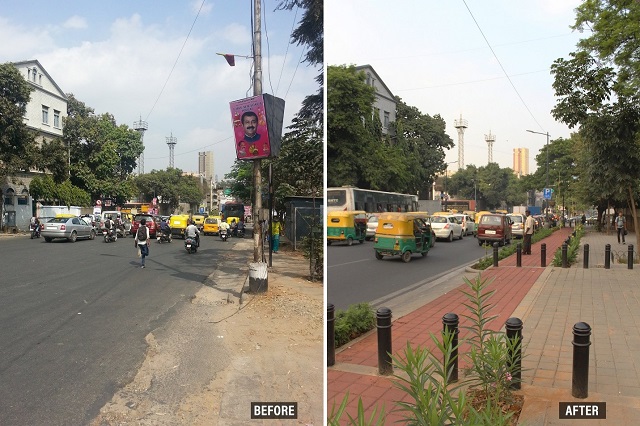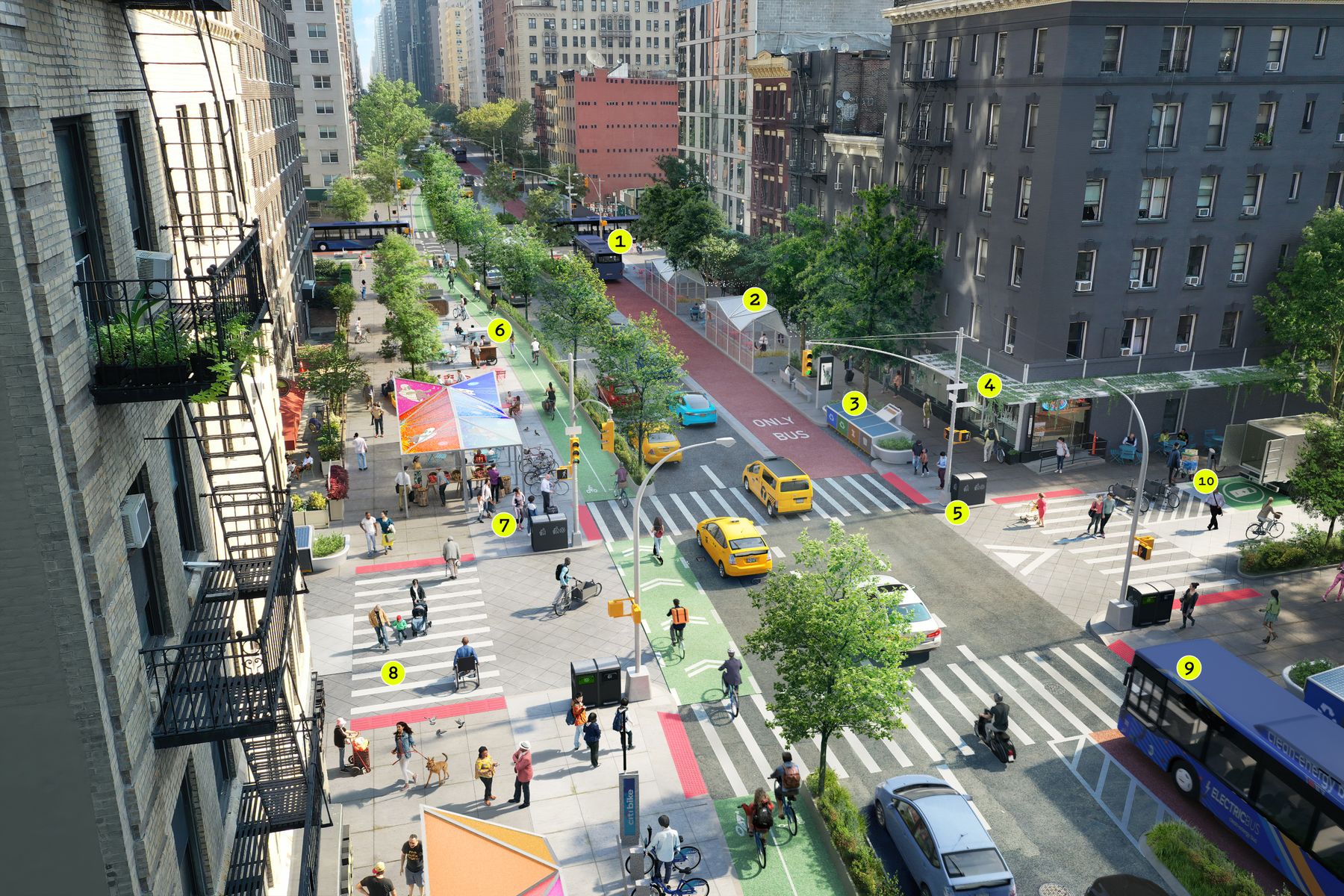Pedestrian-friendly Street: A great asset to the community
Pedestrian-friendly streets are a prodigious strength to the community. They can also attract economic benefits. The presence of such streets can increase retail sales and open up trade. Along with that, it offers a public space for shopping in the neighborhood. The pedestrian-friendly street has countless benefits for small businesses as well.
Pedestrians are not only safer but they are also more relaxed than drivers. A pedestrian-friendly street reduces stress levels by providing walkers with a place where they can take a break from their daily routines. This makes them feel better about themselves as well as their city or town.
Pedestrian-friendly streets increase property values because they make the area look nicer [1]. which eventually increases the demand for housing and commercial space in that area. In addition to these benefits, pedestrian-friendly streets also improve public health, because people who walk to work tend to live a healthier lifestyle. Many benefits come along with having an intervened sidewalk in your neighborhood such as:
- More people will be encouraged to walk instead of driving their cars which will reduce pollution and traffic congestion;
- Pedestrians will have easy access to stores, restaurants, and other businesses that are located in the area;
- Visitors will be able to enjoy their time more since they do not need to worry about being hit by cars or getting lost in traffic;
- It will encourage pedestrian movement which will help improve air quality since there is less traffic on the roads
A sidewalk is a place where people can walk and interact with each other. The sidewalks are where we should be able to walk fast and safely. However, not everyone has been able to enjoy them due to the lack of pedestrian-friendly streets, which is an elementary part of our society.
There are certain ways to improve pedestrian movements on the sidewalk, which are explained in three different sections.
Section: A. Transforming streets into places for people.
The idea behind this suggestion is to transform our streets into pedestrian-friendly places. where people feel safe and comfortable walking, cycling, and using public transport. Also, to create a new space where people can meet their daily needs, such as shopping or eating out.
According to a recent report on walk score [2], making a street into a more walkable place can increase property values by as much as 20 to 30 percent. Streets should also have benches and other seating areas where people can sit while they are waiting for buses or trains, or just enjoying a nice day outside.
In addition to these significant roles of the sidewalk, it serves as a great benefit to the community. By transforming our streets into places for people instead of just drivers, we can create a more walkable neighborhood, that is attractive to residents and businesses alike. These will lead to lower crime rates, higher property values, and increased tax revenue for the city council.

Figure -1, A sidewalk transformation in Bangalore, with fixed bollards to prevent a motor vehicle from encroaching the pedestrian space.
Section: B. Analyse Street activity
Street activity is a sign of the health and vitality of a city [3]. Street activity can be measured by observing the number of people on the street, their ages, occupation, and social status. The number of people on the street can tell us about the economic activity going on in a given area. An increase in the number of pedestrians indicates that there are more opportunities for employment, shopping, and recreation.
The age of pedestrians also indicates the economic condition. A high proportion of elderly people suggests that more pensioners have retired from their jobs, giving them more time to spend on leisure activities such as walking around the neighborhood or shopping at local stores.

Figure -2, An interactive space for pedestrians and local shops.
Section: C. Design for safety and comfort
Pedestrians are usually the most important part of any city’s infrastructure, as they make up the majority of the population. They are also the ones who use sidewalks and walkways, whether they own a car or not. The safety and comfort of pedestrians are a priority for everyone who lives in a city. Pedestrian-friendly streets can be created by taking into consideration the needs of pedestrians, such as:
- Good lighting: there should be enough light at night so that pedestrians can see where they are going and avoid obstacles.
- Clear markings: markings on roads and sidewalks help pedestrians know where they are supposed to walk (for example, if there is a crosswalk).
- Signage: signs should be placed clearly so that pedestrians know what traffic rules apply while crossing roadways.
- Landscaping: plantings on sidewalks create shade in hot weather and provide additional color to streetscapes.

Figure -3, A safety approach for the pedestrian while crossing the street.
The main question here is whether the street is safe for pedestrians. The answer to this question is not straightforward. On the one hand, it is essential to notice that the street was originally designed for cars, so there are many intersections where pedestrians are forced to cross streets [4]. On the other hand, new buildings have been built near these intersections and have become more attractive to pedestrians.
Therefore, it seems that the main pedestrian safety problem in this area is at intersections. If we could somehow lower their number and make them less dangerous, then we would have solved our problem. However, this approach seems ineffective because it would require a lot of money and time [5]. Therefore, we should focus on improving visibility at intersections.
When it comes to creating a pedestrian-friendly street, a community should take the time to plan and execute. This will make the entire process more effective and efficient. The three ways listed above are just a few examples of the options available to give your street a facelift so that it no longer becomes an eyesore, but rather, an asset to the surrounding community.
Not everyone is aware that there are many benefits to pedestrian-friendly streets. A pedestrian-friendly street is an avenue where pedestrians are given priority. With the best traffic condition, creating a safe and pleasant place to walk, study and work. The more pedestrian-friendly streets we have in our communities, the better their residents and their economic growth will be [6].
References:
[1]. Creating a pedestrian-friendly utopia through the design of 15 minutes cities, by Kaley Overstreet.
[2]. Walk score 2022
[3]. 6 ways to make city streets safe for pedestrians, by Nikita luke.
[4]. Perfecting the new york city, by Justin Davidson.
[5]. One thing every city can do to be more pedestrian friendly.
[6]. The use of sidewalks: safety, by Jane Jacobs.
Image references:
Fig-1 bhttps://thecityfix.com/wp-content/uploads/2020/05/Nikita-Photo-1.jpg
Fig-2 https://media.wired.com/photos/59323f9a26780e6c04d2a80e/master/w_4272,h_2848,c_limit/5965876882_86b6e5279b_o.jpg
Fig-3 https://www.google.co.in/url?sa=i&url=https%3A%2F%2Fwww.curbed.com%2F2021%2F11%2Fperfecting-nyc-street.html&psig=AOvVaw0RZgyvKUew_0A6rK3SANry&ust=1668990641527000&source=images&cd=vfe&ved=0CA8QjRxqFwoTCJDsy-PAu_sCFQAAAAAdAAAAABAX.






Wanting to create friendly streets, I see the street as the most heavily used public space. Designing for all ages is important and the article does not address the relevant ones. The article talks about the need to consider design around child-friendly, youth-friendly and age-friendly streets in safe and comfortable design in order to create innovative and vibrant livable patterns. And because the most important function of streets as linear elements of urban public space is to meet access, especially living streets, promoting the renovation and upgrading of accessibility facilities, promoting age-friendly renovation of homes for the elderly, and creating more right external places for youth to grow and learn and consumer scenes can effectively enhance the vitality and accessibility of urban related communities.
The article suggests that streets assume an important role in the social life and interpersonal interaction of streets, especially living streets with a focus on the provision of public services and a concentration of public activity attributes, which often have more direct and effective spontaneous contact with residents. Yet there is little targeted design to meet the needs of children. However, high-frequency and time-consuming activities still occur mainly in ‘informal’ spaces such as street sides and open spaces.
Safety is still at the forefront of child-friendly urban streets and is a primary consideration. In combination with the analysis of the two streets mentioned above, the design can be optimised in terms of road level and landscape planting: firstly, in pedestrian spaces, the ground is the most direct perceptual surface for users, and uneven surfaces increase the risk of children falling when they walk and play on the street. Secondly, in the selection of landscape plants, toxic, irritating, pollen-rich and sharply shaped plants should be avoided.
The article also mentions providing diversity in the street space environment by analysing the functional areas of the street. Children are curious by nature and a child-friendly street must also be spatially diverse. In the context of the article’s analysis, two aspects can be considered in relation to the function of the land and infrastructure surrounding the street: firstly, a moderate increase in the functional mix of living streets can help to increase children’s curiosity about the street. Secondly, the updated design of the stay space on both sides of the street needs to take into account not only the diversity of children’s needs in terms of street infrastructure, but also the resting and waiting needs of accompanying parents and elders.
Combined with the street activities so analysed in the article, all-age friendly communities and high quality neighbourhoods for consumption, recreation, business and other travel needs, the construction of urban street spaces should further improve the systemic, connectivity, safety, landscape and comfort of the pedestrian network by improving the pedestrian network, ensuring the width and smoothness of pedestrian zones, improving pavement parking, and improving pedestrian crossing facilities and barrier-free facilities.
Hi Jagriti,
I hope you are doing well. For professionals like architects and urban designers, pedestrian-friendly streets are a particularly fascinating issue. I firmly believe that pedestrian areas are crucial for members of the public, including individuals who frequently stroll in the morning, street sellers, and the city itself. I can see that some areas of the World lack pedestrian areas.
I believe it would have been excellent if she had used the example of a street that is designated as a pedestrian area but where people may enjoy street markers on weekends when she was explaining public spaces for shopping. At many parts of the world, Sunday markets or weekend markets are highly significant for the community and the city because they attract shoppers and allow them to purchase goods at lower prices than they might in a store. That started to draw people in. Some streets, such as Newcastle’s Northumberland Street, have converted entirely to pedestrian traffic.
Being an Architect, I would like to advise that there be some materials, such as various types of stone for Pedestrian Streets where people may stroll about without shoes. These materials can act as acupressure on the feet. It is not necessary to plan an entire street; rather, only a small section of it would suffice. I believe this is an excellent concept for elderly folks to create a site of interest. These types of paving are low maintenance and economical, and most people can see this idea in gardens.
Additionally, in some countries people are celebrating a Pedestrian Day where citizen cannot use vehicles except in some case even Prime Minister also go one place to another place by walk. I think this information is relate to this blog. I wholeheartedly concur that pedestrian-friendly areas may boost economic growth, lessen traffic, and promote health.
In conclusion, this blog is very educational and beneficial for certain cities with a shortage of pedestrian space, and I hope that my example will assist to establish a variety of pedestrian areas.
References: https://serenityinthegarden.blogspot.com